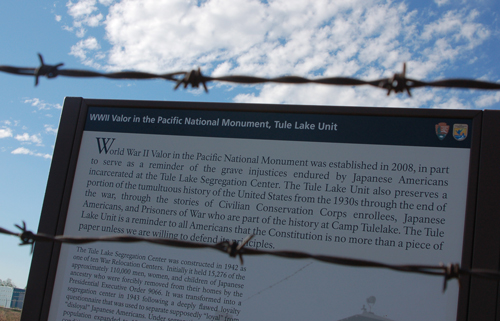
The northeastern corner of California is a remote and sparsely populated place. The other day, we missed an unmarked turn-off and drove an extra hundred miles, regretting the trip not at all. Where else would we have encountered in a few hours such an expanse of second growth pine forest, fertile valleys, and high desert?
Our first destination was Lava Beds National Monument, acre on acre of rocky grassland that is actually a huge crater of a long ago volcano. The land is honeycombed with caves and hummocks formed by lava flows that have since eroded.
The Lava Beds were also the site of what one display in the visitor center called perhaps the most expensive war, for its size, this country has ever fought. In 1872-3, a tiny band Modoc Indian warriors held at bay some 600 U.S. soldiers attempting to capture and remove them from the land.
The Modocs even killed a U.S. army general during the hostilities.At no time during the Modoc War were there more than 53 Modoc warriors engaged in the fighting. ...
It has been estimated that the Modoc War cost the United States over $400,000; a very expensive war in terms of lives and dollars, considering the small number of opposing forces. In contrast, the estimated cost to purchase the land requested by the Modoc for a separate reservation was $20,000.

It's not hard to imagine how a tiny group who knew the land could hide and fight in this sort of terrain. That's one of the hazards of fighting in other peoples' countries.

Nearby, a couple of forlorn signs behind a fence mark the undeveloped site of the Tule Lake Segregation Center, also a National Monument, though it would be hard to tell as the signs are the only evidence. (There's also a temporary museum several miles down the road, but it was too late in the day for us to go there.) A flyer available at the Lave Beds explains:
The Tule Lake Segregation Center, beginning as one of ten relocation centers established throughout the United States under the auspices of the War Relocation Authority, held 18,789 of the 120,000 men, women, and children of Japanese ancestry who were displaced from their homes and forcibly moved to the Centers. It was transformed into a Segregation Center in 1943 when a Loyalty Questionnaire was used to separate the supposedly "loyal" from the "disloyal" internees. Due to the harsh conditions of the Center, strife and controversy arose. This led to the construction of a stockade, , with a jail, and the implementation of martial law.

...The Tule Lake Unit is a reminder to all Americans that the Constitution is no more than a piece of paper unless we are willing to defend its principles.

Out on the highway, the state of California, in cooperation with the Japanese American Citizens League, has placed a marker that even more bluntly repudiates this shameful episode.
Never again indeed.Tule Lake was one of ten American concentration camps established during World War II to incarcerate 110,000 persons of Japanese ancestry, of whom the majority were American citizens, behind barbed wire and guard towers without charge, trial, or establishment of guilt. These camps are reminders about how racism, economic and political exploitation and expediency can undermine the Constitutional guarantees of United States citizens and aliens alike. May the injustices and humiliation suffered here never recur.
No comments:
Post a Comment